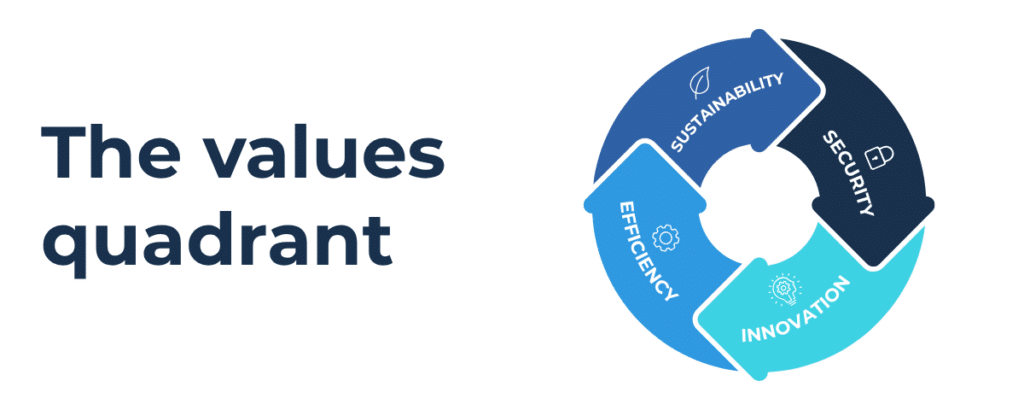
It is no longer heresy to claim that your company’s security has reached the same value as the quality of your products or services in the eyes of your customers.
In the hierarchy of values that define your competitive landscape, a new and increasingly important element has emerged: security. Product quality, customer service level, brand awareness, pricing, and… security.
The latest developments in the ongoing process of industrial transition are demonstrating that a company’s digital reliability is becoming a crucial factor for its competitive positioning.
Today, factors such as supply chain solidity, the absence of cyberattacks, and the ability to respond effectively to incidents have become key elements that can significantly influence the decision-making processes of partners, customers, and investors.
This awareness is now clear to most large enterprises, which are leveraging this new factor within their market and communication strategies.
Companies like Siemens and Schneider Electric have successfully transformed the concept of “security embedded”—protection integrated from the design phase—into a differentiating market value and a true communication asset. The security factor of a product is no longer perceived as an extra cost or a regulatory obligation, but as a strategic advantage to stand out from competitors, even when offering higher-priced solutions.
On August 1, 2023, Schneider Electric announced the launch of Managed Security Services (MSS) for operational environments (OT)—a clear step toward “security embedded” in industrial systems.
In 2024, Siemens published the whitepaper “Building X Cybersecurity”, declaring that “security by design & default” is an integral part of its digital building platform.
Ensuring the resilience of industrial infrastructures today means offering reliability, operational continuity, and trust to customers.
In this way, security has evolved from a technical requirement into a commercial and positioning lever in an increasingly competitive market.
Companies with mature and structured security processes not only reduce their exposure to risk (and the costs of potential incidents) but also become more attractive to clients, partners, and investors.
In today’s context, most stakeholders already consider cybersecurity and risk management as primary factors in evaluating the value of a supplier or an investment.
In B2B markets, trust must be considered a true currency of exchange.
Following the well-known NotPetya attack in 2017 , logistics leader Maersk rebuilt its IT infrastructure in just ten days, strengthening its reputation thanks to transparency and rapid response.

Every action aimed at improving security—by integrating tools and controls into daily operations—may initially require investments and process adjustments.
However, these improvements do not slow innovation; they enable it.
When processes and data are under control, it becomes easier and faster to introduce new technologies, experiment with hybrid production models, and scale operations efficiently.
Each well-designed protection measure reduces downtime, decision-making delays, and resistance to change—barriers that often prevent companies from adopting new tools or processes in support of innovation.
According to MIT CISR, “future-ready” enterprises—those with strong cybersecurity capabilities—achieve average revenue growth of +17.3 percentage points, with net margins 14 points above the industry average.
Further studies by MIT CISR and Accenture confirm that organizations with a mature approach to digital security are also the most innovative.
The correlation is clear: robust cybersecurity governance builds trust, accelerates decision-making, and allows faster, safer adoption of new technologies.
In other words, security does not slow innovation—it makes it more efficient and sustainable, creating a virtuous cycle in which the growth of each value amplifies the others.
The most technologically advanced companies—those with a strong cybersecurity focus—treat risk data as business intelligence, on par with revenue, forecasts, and profits.
Risk and security insights are regarded as essential elements for guiding investments and operational decisions.
They do not just measure threats—they understand how threats affect productivity, supply chains, and corporate reputation.
Failing to know and measure one’s level of risk means hiding dangers that could emerge at any moment and cause unimaginable damage.
Conversely, when risk becomes measurable and predictable, it turns into knowledge—a source of competitive advantage.
In today’s industrial scenarios, where companies are finally assigning the right priority to security, the true differentiator is not who invests the most in technology—but who can transform complexity into trust, and security into value.
This opens up new opportunities for companies capable of adopting innovative and secure approaches, placing security at the heart of their strategy.
Being “secure by strategy” means not only being protected—but also being credible, sustainable, and highly competitive.
ai.esra SpA – strada del Lionetto 6 Torino, Italy, 10146
Tel +39 011 234 4611
CAP. SOC. € 50.000,00 i.v. – REA TO1339590 CF e PI 13107650015
“This website is committed to ensuring digital accessibility in accordance with European regulations (EAA). To report accessibility issues, please write to: ai.esra@ai-esra.com”
ai.esra SpA – strada del Lionetto 6 Torino, Italy, 10146
Tel +39 011 234 4611
CAP. SOC. € 50.000,00 i.v. – REA TO1339590
CF e PI 13107650015
© 2024 Esra – All Rights Reserved